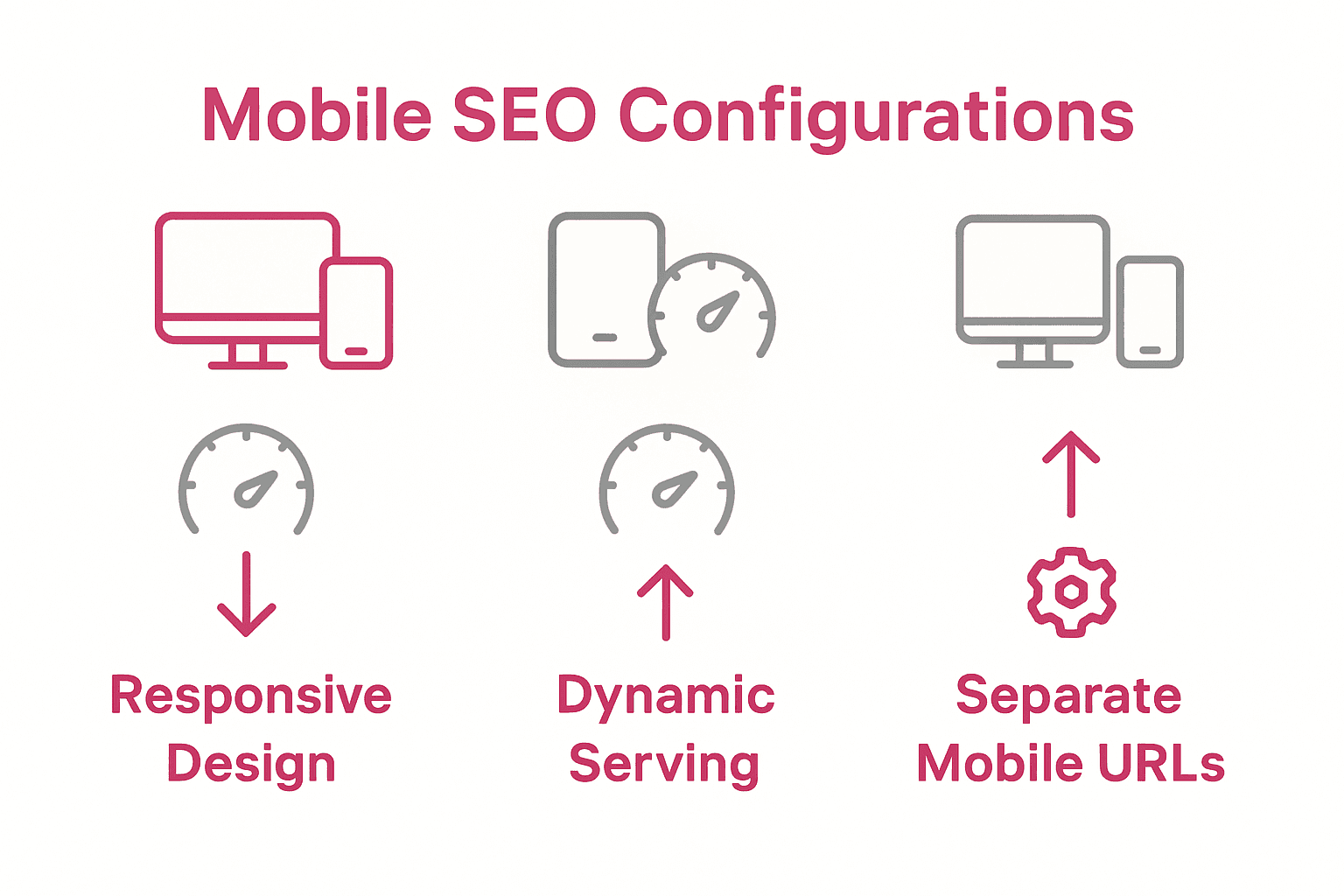Mobile SEO: Complete Guide for eCommerce Owners
- Darren Burns
- 3 hours ago
- 7 min read

More than half of all internet traffic now comes from mobile devices, yet many ecommerce businesses still struggle to meet these users’ expectations. With mobile searches driving purchasing decisions at a record rate, failing to optimize your website can quickly leave you behind. Understanding mobile SEO means uncovering the strategies that not only improve your search rankings but also deliver a faster, smoother shopping experience for every customer reaching for their phone.
Table of Contents
Key Takeaways
Defining mobile SEO and its importance
Mobile SEO represents a critical digital strategy for modern ecommerce businesses targeting smartphone users. According to TheAJCenter, mobile SEO involves optimizing websites to perform and rank higher in mobile search engine results, reflecting the dramatic shift towards mobile internet consumption.
With over half of all internet traffic now originating from mobile devices, understanding mobile optimization is no longer optional it’s essential. As Decipher Zone highlights, mobile optimization encompasses multiple strategic elements designed to enhance user experience and drive conversions. These key components include:
Responsive design that adapts seamlessly across different screen sizes
Rapid page load speeds ensuring quick content delivery
Mobile-friendly content layouts
Touch-friendly navigation interfaces
Search engines like Google have already implemented mobile-first indexing, which means they predominantly use the mobile version of a website’s content to determine ranking and visibility. This fundamental shift underscores why ecommerce owners must prioritize mobile SEO. By creating a mobile-optimized experience, businesses can capture more traffic, improve search rankings, and ultimately drive higher conversion rates in an increasingly mobile-dominated digital landscape.
Successful mobile SEO requires a holistic approach that goes beyond mere technical adjustments. It demands a deep understanding of how mobile users interact with digital content and a commitment to delivering exceptional user experiences across all devices.
Variations and configurations of mobile SEO
Mobile SEO encompasses multiple technical and strategic configurations that ecommerce owners must understand to optimize their digital presence. These variations range from technical implementation to content adaptation, ensuring websites perform seamlessly across diverse mobile devices and platforms.
The primary configurations of mobile SEO can be categorized into several key approaches:
Responsive Design: A fluid layout that automatically adjusts to different screen sizes and orientations
Dynamic Serving: Delivering different HTML content based on the user’s device
Separate Mobile URLs: Creating distinct website versions for mobile and desktop users
Each configuration presents unique advantages and challenges.
Responsive design offers the most streamlined approach, allowing a single website version to adapt dynamically. Dynamic serving provides more customized experiences but requires more complex technical implementation. Separate mobile URLs give granular control but can complicate website management and potentially create duplicate content issues.
To complement these technical strategies, eCommerce owners should also focus on mobile-specific optimization techniques. These include optimizing page load speeds, implementing touch-friendly navigation, ensuring readable font sizes, and minimizing intrusive pop-ups. Learn more about foundational SEO principles in our SEO Basics Guide, which provides comprehensive insights into creating a robust digital strategy.
Ultimately, successful mobile SEO requires a holistic approach that balances technical excellence with exceptional user experience. By understanding and implementing the right mobile configuration for your specific business needs, you can significantly enhance your website’s performance and search engine visibility.

How mobile SEO works for eCommerce sites
Mobile SEO for eCommerce sites is a sophisticated process that involves optimizing every aspect of a website to perform exceptionally well on mobile devices. According to Decipher Zone, the core focus is on creating a seamless mobile experience that enhances user engagement and drives conversions.
The key technical elements of mobile SEO for eCommerce sites include:
Responsive Design: Automatically adjusting layout and content to fit different screen sizes
Page Speed Optimization: Ensuring rapid load times on mobile networks
Mobile-Friendly Navigation: Creating intuitive touch-based interfaces
Compressed Media: Reducing image and video file sizes without compromising quality
Specifically for eCommerce platforms, mobile SEO requires additional strategic considerations. Product images must be optimized for quick loading and clarity, while product descriptions need to be concise yet informative. The checkout process should be streamlined, with minimal form fields and easy-to-use payment options. These details directly impact user experience and conversion rates.

To gain a broader understanding of digital marketing strategies that complement mobile SEO, explore our comprehensive guide on digital marketing for eCommerce success. By integrating mobile SEO with a holistic digital marketing approach, eCommerce businesses can create a powerful online presence that attracts, engages, and converts mobile users effectively.
Ultimately, successful mobile SEO for eCommerce is about creating a frictionless, engaging experience that meets the unique needs of mobile users. It requires continuous testing, optimization, and a deep understanding of mobile user behavior and technological constraints.
Key mobile SEO strategies for ranking
Ranking effectively in mobile search results requires a multifaceted approach that goes beyond traditional SEO techniques. Mobile SEO demands a strategic combination of technical optimization, content refinement, and user experience enhancement to succeed in increasingly competitive digital landscapes.
The most critical mobile SEO strategies for improving search rankings include:
Page Speed Optimization: Reducing load times to under 3 seconds
Mobile-First Design: Ensuring responsive layouts that adapt seamlessly
Accelerated Mobile Pages (AMP): Implementing lightweight page versions
Structured Data Markup: Helping search engines understand content context
Touch-Friendly Navigation: Creating intuitive mobile interfaces
Content optimization plays a crucial role in mobile SEO ranking. This means crafting concise, easily digestible content that loads quickly and provides immediate value to mobile users. Keywords should be strategically placed, with a focus on natural language and conversational search patterns that align with mobile user behavior.
To gain deeper insights into comprehensive SEO strategies, consider exploring our guide to SEO auditing, which can help you systematically improve your mobile search performance. Advanced mobile SEO requires continuous monitoring, testing, and adaptation to evolving search engine algorithms and user expectations.
Successful mobile SEO is not just about technical implementation but creating a holistic user experience that meets the unique needs of mobile searchers. By prioritizing speed, usability, and contextually relevant content, eCommerce sites can significantly improve their mobile search rankings and attract more potential customers.
Common mobile SEO mistakes to avoid
Mobile SEO is fraught with potential pitfalls that can dramatically undermine an eCommerce website’s search performance and user experience. According to Harvard Media, several critical mistakes can quickly derail mobile search optimization efforts, particularly around content accessibility and site performance.
The most significant mobile SEO mistakes eCommerce owners should avoid include:
Unplayable Content: Using technologies like Flash that aren’t supported on mobile devices
Intrusive Interstitials: Implementing pop-ups that obstruct main content
Slow Page Load Times: Allowing pages to load beyond 3 seconds
Non-Responsive Design: Failing to create adaptive layouts
Complex Navigation: Designing interfaces that are difficult to use on smaller screens
As Design Me Marketing emphasizes, these mistakes can lead to significant user engagement problems, including higher bounce rates and reduced search rankings. Technical elements like site speed and mobile-friendly design are not just recommendations but essential requirements for modern digital success.
For a comprehensive understanding of how to avoid these pitfalls and improve your overall digital marketing strategy, explore our marketplace SEO guide. Successful mobile SEO requires continuous learning, adaptation, and a commitment to creating seamless, user-centric experiences that meet the evolving expectations of mobile users.
Unlock Your eCommerce Potential with Expert Mobile SEO Support
Mastering mobile SEO involves overcoming challenges like slow page load times, unresponsive designs and frustrating navigation. These obstacles can cause shoppers to abandon carts and lower your rankings. If you want to provide a seamless mobile experience with fast speeds and touch-friendly interfaces you need tailored strategies backed by proven expertise.

Take control now by partnering with seasoned specialists who understand the precise demands of mobile optimisation for eCommerce. At iwanttobeseen.online, our 25 years of experience scaling top eCommerce brands helps you avoid common pitfalls and implement winning tactics like responsive design, compressed media and mobile-first layouts. Explore our SEO Basics Guide to build a solid foundation and visit our main site to discover how our tailored digital marketing services can transform your mobile presence and boost your search rankings. Don’t wait until visitors slip away due to poor mobile experience act today and future-proof your ecommerce growth.
Frequently Asked Questions
What is mobile SEO and why is it important for eCommerce?
Mobile SEO involves optimizing websites for better performance in mobile search results. It is crucial for eCommerce since over half of all internet traffic comes from mobile devices, and mobile-first indexing by search engines prioritizes the mobile version of web content for visibility and ranking.
What are the key components of mobile SEO?
Key components of mobile SEO include responsive design, rapid page load speeds, mobile-friendly content layouts, and touch-friendly navigation interfaces, all aimed at enhancing user experience and increasing conversions on mobile devices.
How can I improve my eCommerce site’s mobile SEO?
To improve mobile SEO for your eCommerce site, focus on optimizing page load speeds, ensure responsive design, create mobile-friendly navigation, optimize product images, and streamline the checkout process to enhance the mobile user experience.
What common mistakes should I avoid in mobile SEO?
Common mobile SEO mistakes include using unplayable content formats like Flash, having intrusive pop-ups, slow page load times beyond 3 seconds, non-responsive designs, and complex navigation that hinders user experience on mobile devices.
Recommended
.png)
Comments